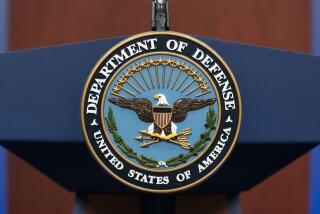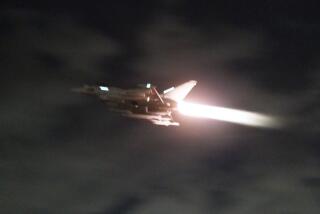Iraq’s Kuwait, Saudi Border Force Grows
- Share via
WASHINGTON — The Iraqi military has massed an estimated 265,000 men in Kuwait and on the Iraqi-Saudi Arabian border, marking a substantial increase over the past several days, according to the latest U.S. intelligence estimates.
The Iraqi troop concentration includes 1,500 tanks, 1,200 other armored vehicles and 800 artillery pieces, Pentagon officials said Tuesday.
A Pentagon spokesman said the Iraqis have dug into defensive positions but are “capable of shifting to an aggressive offensive posture very quickly.” He said there are 150,000 Iraqi troops in Kuwait and 115,000 in “contiguous areas” along the Saudi border.
As recently as Aug. 22, government defense analysts estimated that 195,000 Iraqi troops were in Kuwait and southern Iraq, within striking distance of Saudi Arabia.
The United States currently has an estimated 50,000 Army and Marine Corps troops on the ground in Saudi Arabia, with as many as 100,000 more combat and support troops on the way and expected to arrive by the end of September.
The Navy armada of 70 ships in the region or en route is manned by about 50,000 sailors, while the Air Force has dispatched an estimated 30,000 personnel to support the 300 combat and transport aircraft deployed in the area.
Meanwhile, the first major problems emerged in the massive three-week deployment of troops and equipment to Saudi Arabia. Only five of the 38 reserve ships activated to carry weapons, ammunition, food and other supplies to the Saudi desert were able to respond in the required time, Army officials complained, leaving critical equipment sitting on U.S. piers awaiting transport to the troops.
But despite the snafu in equipment transport, the overall buildup is proceeding relatively smoothly. When it is completed in three or four weeks, defense officials now say, the United States will have dispatched well over 200,000 ground, sea and air troops to the region.
But senior military officials in Washington cautioned that the forces today can do no more than fight the 15 Iraqi divisions on the Saudi border to a standstill, and would not be ready to contemplate an attack until late September at the earliest, when the full 4 1/3-division Army force is in place.
The new figures on both sides suggest that while U.S. strength on the ground has improved, U.S. troops are not yet in position to back up tough Administration rhetoric about bringing any conflict with Iraq to a rapid and successful conclusion.
“We’re not prepared to take offensive action,” a senior military planner said Tuesday. “We have to keep building our capability. This is slow, this is methodical, and it’s going to last a long, long time.”
Another defense official in Washington said Iraqi President Saddam Hussein, too, is “slowly but surely building his forces” on the Saudi border. A week ago the elite Republican Guards moved out of Kuwait and back into Iraq, presumably to be closer to supply lines and to have additional room to train and maneuver, U.S. military authorities said.
The Iraqi forces “constitute a significant threat to Saudi Arabia,” defense officials said.
Hussein’s troops face a growing U.S. ground force that in the past two days has been markedly strengthened by the arrival of hundreds of heavy M-1 Abrams tanks, self-propelled artillery and armored personnel carriers.
The newly arrived armor prompted some U.S. ground commanders in Saudi Arabia for the first time to openly speculate about offensive operations against the Iraqi troops.
The problem with materiel transport involves cargo ships from the Ready Reserve Fleet, an armada of retired merchant ships kept in mothballs for emergency military use. They are maintained by the Maritime Administration, an agency of the Transportation Department, and are supposed to be ready on notice of five, 10 or 20 days.
A Maritime Administration official acknowledged the delays but said that all the ships arrived at their designated ports before their military cargo was ready for loading.
But a senior Army official said that virtually all of the ships pressed into service since Aug. 10 have been late and “in every case troops, vehicles, ammunition were on the dock or at the port before the ships got there.” He said that many of the ships are still at sea with material that should have been delivered to troops in the field days ago.
A spokeswoman for the Navy’s Military Sealift Command, which provides the ships to the other services, disputed the Army’s figures, saying that 12 of 39 Ready Reserve Fleet ships were ready for loading on time.
She said that 17 of the ships were one to five days late, six ships were six to 10 days late and four freighters were 10 to 20 days late.
“It’s important to recognize that we knew this was going to happen,” said the spokeswoman. “We’ve activated them before in exercises and experienced many of the same problems.”
Meantime, in Dhahran, Saudi Arabia, the center of the U.S. military buildup on the Arabian Peninsula, scores of the Army’s top-of-the-line M-1 tanks, armored fighting vehicles and attack helicopters baked in a withering Saudi sun Tuesday as the U.S. 24th Mechanized Infantry Division formed convoys that stretched for miles as they moved into the desert to stare down Iraq’s tank force.
The heavy equipment was displayed as part of a concerted effort by the U.S. military to publicize its growing presence in Saudi Arabia, hoping that such media images will persuade Hussein that any attack would be massively resisted.
The armor, which brings to U.S. ground troops in the region their heaviest firepower yet, arrived in Saudi Arabia from its home at Ft. Stewart, Ga., after a two-week journey in two fast sealift vessels, the Navy ships Capella and Altair. The ships now are expected to return to the United States to collect still more heavy equipment for the unrelenting buildup of U.S. troops.
Defense officials have said that forces like the 24th Division will take up defensive positions along the most likely routes of attack close to the Saudi border with Iraq.
But while mechanized troops like those in the 24th are in Saudi Arabia ostensibly to serve as a deterrent to Iraqi attack, many officers here assert that the force could also serve as the point of a U.S.-Saudi offensive designed to roll Saddam Hussein’s troops out of Kuwait.
“We are well prepared for offensive action, if we’re given orders to do so,” said Lt. Col. Terry Stanger, commander of a tank battalion of the 24th. “We’re very well trained and equipped for both defensive and offensive operations. And we think we have some advantages” over Iraq’s 1,500-tank force, Stanger added as he watched dozens of M-1 tanks rumble out of their dockside parking lot toward their desert positions.
A U.S.-Iraqi tank battle, if it should occur, would pit a rigid Iraqi army against an American force that relies on soldier initiative and a combination of aircraft, anti-tank weapons, electronic jamming and old-fashioned tank traps to delay and harass an enemy.
“They have a tendency to have a plan that is thoroughly rehearsed and rigidly executed, and there are some things we can do to take advantage of that,” Stanger said.
Col. John LeMoyne, division chief of staff, told reporters that it is too early to consider American forces capable of offensive action. But with the long-awaited arrival of the unit’s equipment, LeMoyne said the U.S. military commander gains “a significant combat power that gives him great flexibility.”
A member of the House Armed Services Committee said after a classified briefing about the crisis that he feels “much better about the danger of hostilities, of actual shooting and casualties” in the Persian Gulf.
He said Administration officials had told the committee that “this buildup is big for a specific purpose--we don’t want anybody to die.” He added: “It’s big, and it’s going to continue to get bigger.”
The arrival of the Army’s big guns and its fiercest tank-killers also comes as U.S. intelligence analysts contemplated ambiguous signs that Iraq is taking pains to avoid an unintended escalation of hostilities.
The Iraqi air force has kept many of its planes on the ground, although single planes appear to probe the border here on occasion. Meanwhile, Iraq’s ground forces in Kuwait have rotated in such a way that some of the best forces appear to have gone to the rear.
“He doesn’t want to start it, to do anything silly that might start something. That’s the sense we’re getting,” said one officer in Saudi Arabia.
Broder reported from Washington and Healy from Saudi Arabia.
More to Read
Sign up for Essential California
The most important California stories and recommendations in your inbox every morning.
You may occasionally receive promotional content from the Los Angeles Times.











